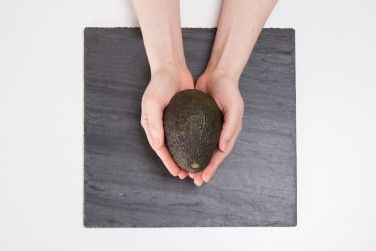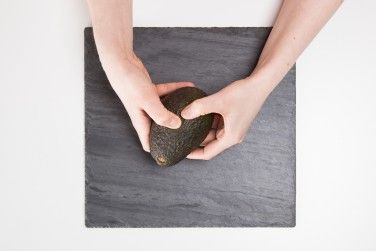Our love of avocados runs deep. And really, how could it not? They’re the creaminess in our smoothie, the buttery topping on our toast, and the guac-y goodness on our tacos. And that’s just the tip of the corn chip when it comes to their uses: We found 39 delicious ways to get our fix. That’s a lot of avocado! You better believe the Greatist kitchen is regularly stocked with a pyramid of this pear-shaped fruit.
Thankfully we’ve picked up a few tips when it comes to selecting, storing, and prepping avocados so we can maximize each one—and minimize our chances of ending up with brown mush or a flavorless rock. All the better since eating more ripe, ready-to-eat avocados means more vitamins B6 and E and more “good” monounsaturated fat in our diets. Go ahead and rock the guac with these pointers.
Pick the Perfect Avocado
1. Check the skin.
The bumpy alligator skin of a typical Hass avocado starts out dark green and ripens to eggplant color, says licensed nutritionist Monica Reinagel, author of Nutrition Diva’s Secrets for a Healthy Diet. This hue is key. If you’re looking for an avocado you can eat tonight, you want one with dark green to purple-y or brown skin. If you’re looking to stock your kitchen with a few fruits you can eat later, shop for one that’s mid to dark green. Then make sure there aren’t any deep scratches or scrapes on the outside that could affect the fruit inside. If you spot larger, smoother, leather-y avocados that are bright Kelly green, those are the Florida variety. “These have less fat and more water, so they’re lower in calories but also not quite as creamy.Unless a recipe specifically says Florida avocado, I always assume to use ‘Hass,’” Reinagel says. The color also stays more or less the same as it ripens, so use the steps below to pick the perfect Florida fruit.
2. Give it a squeeze.
Press down on the avocado with your thumb. A good one will have a little give rather than feeling like you’re pressing against a wall. “Ripeness is best determined by pressure because softening of the fruit can happen at any rate, independent of the color,” says Emiliano Escobedo, executive director of the Hass Avocado Board. But don’t make the mistake of thinking more give equals more goodness. If your thumbprint stays indented or the flesh feels squishy, skip it, as it’s likely overripe, Escobedo adds.
3. Peek under the stem.
Here’s a trick that’s circulating around the Internet: If you pop the little button stem off the top end of the avocado, it’ll tell you if the avocado is a good candidate. If the skin under it is green, you’re good to go. If the skin under it is brown, it’s past its prime. But there’s a huge caveat: “When you pop off the stem, you allow air to enter into the avocado, which can cause premature oxidation and browning. So leave those stems on until you’re ready to eat the avocado,” Reinagel says. Removing the stem at the store can also create an opportunity for the avocado to rot without ripening, says Mary Dawn Wright executive research chef of the Sabra Dipping Company.
Ripen Avocados
If the countdown to guacamole is on and you’re getting impatient, you can try the following method to speed up the fruit’s ripening process:
1. Brown bag it with other fruit.
Get a paper bag and put your avocado in there. In a contained space, your avocados will circulate ethylene, a gas that helps fast-forward the ripening process.And skip the plastic. “You wouldn’t want to use a plastic bag to ripen fruit because along with the ethylene gas, it also traps moisture, which can cause the fruit to mold or rot,” Reinagel says.Fruits like apples, pears, plums, bananas, and cantaloupes also produce ethylene. And the more the merrier when it comes to speeding along the ripening process, so tuck in a couple other pieces of fruit with your avocado.
2. Give it time.
Seal up the bag and keep it at room temperature. In this climate the avocado will ripen in two to three days, Escobedo says. (On the flipside, you can chill avocados in the fridge away from other produce to slow down the ripening process. They’ll stay fresh for about five days in the fridge.)Note: Some common hacks include putting an unripe avocado in the oven or microwave. While this will leave the flesh soft enough to mush into submission, it won’t let the flavor develop. “Popping an unripe avocado in the microwave or oven won’t make it any riper. You’ll just have a cooked, unripe avocado,” Reinagel says.
Cut and Prep an Avocado
1. Cut the avocado lengthwise.
Ready to bust into one of these ripe beauties? Start by splitting it in half. Set the avocado down lengthwise on a cutting board. With your kitchen knife parallel to the board, slice straight through the middle till you hit the pit. Then spin the fruit around. “After slicing all the way around, hold the avocado in the palm of one hand and use the other hand to twist and rotate the halves apart,” Escobedo says.
2. Extract the pit.
If you’re not shy about wielding a blade, try Wright’s technique: “Hold the avocado half in your hand, and gently tap it with the knife until the knife sticks into the avocado pit.Rotate the knife by twisting your wrist, and the pit will come out,” she says. If you’re a little reluctant to clock the pit with a kitchen knife, use Escobedo’s method: “Slip a spoon between the pit and the fruit, and gently work it out of the flesh.” (Just know you may lose a little of the flesh with this method.)
3. Slice and cut.
Delicately use your knife to cut through in vertical slices. Use just enough pressure that you hit the back of the skin but not so much that you pierce through it. “If you want slices or cubes, you can score the flesh in whatever shape you want,” Reinagel adds.
4. Scoop out the good stuff.
Now that it’s properly sliced, use a back of a spoon to scoop the flesh out from the skin. Make sure to edge the spoon as close to the skin as possible.
5. Serve and eat, or store.
What are you waiting for? Dive right into those slices and gobble them up in every way: dips, soups, salads, smoothies, you name it! Don’t plan on using the whole avocado in one go? We salute your self-restraint! To keep leftovers fresh and bright, save the half with the pit. The Hass avocado site recommends squeezing a lemon over the flesh, which can help prevent oxidation. Then wrap it up in plastic wrap, making sure the wrap is pressed directly down on the flesh, and pop it in the fridge. Once prepped like this, avocado halves will keep for two days.


